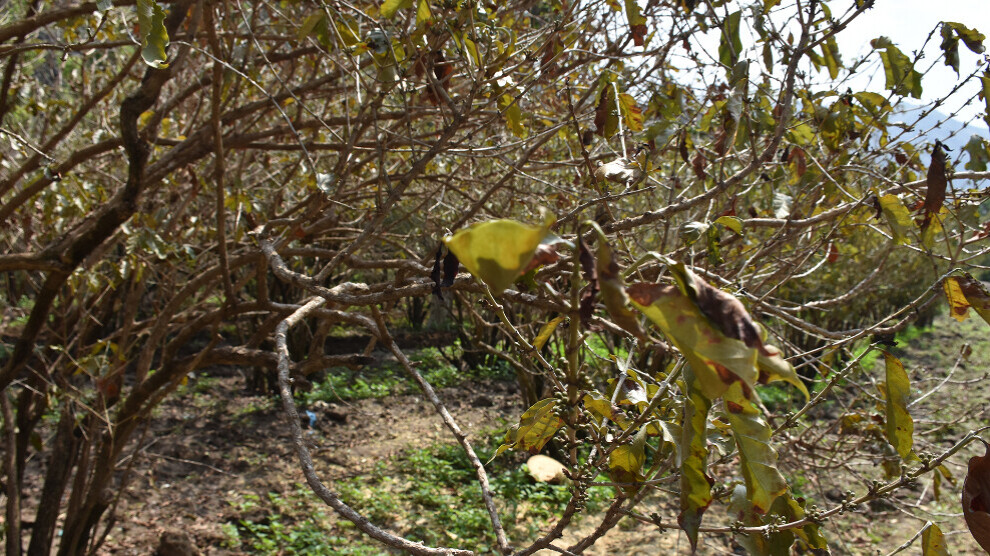Decline in Yemeni Coffee Production Deprives Farmers of Their Only Source of Income
Farmer Saud Mohammed Farea lost her coffee harvest this year — her only source of income — which used to provide enough for her and her family throughout the entire year.

Rania Abdullah
Yemen — Farmers across Yemen have suffered from scarce and irregular rainfall. After a long wait, rain finally fell on parts of Taiz city in southwestern Yemen, but it was neither sufficient nor timely for coffee trees that rely on water during crucial growth stages.
When coffee plants begin to blossom, farmers fervently pray for steady and adequate rain so that the flowers turn into ripe coffee cherries.
Farmer Qubool Mohammed Ibrahim from the village of Al-Mansaha in the Saber Al-Mawadem district of Taiz used to harvest coffee annually, with yields sufficient to sustain her family for the entire year. Like most farmers in the region, coffee was her sole source of income. However, this season saw a dramatic decline in production. The trees did not yield as usual. She explains,
“This year, the rains came late. The coffee trees needed water during the flowering period, but unfortunately, the rains were delayed, so the beans didn’t grow as they should.”
She adds with sorrow,
“Drought hit our farms. The trees dried up, and the rain fell only two or three times this year — not enough for coffee trees, especially during the flowering stage necessary for full maturation.”
Traditional Methods and Climate Challenges
Yemeni coffee is among the oldest and most renowned agricultural products in the country. According to a 2025 FAO (Food and Agriculture Organization of the United Nations) report on Yemen’s coffee value chain, approximately 34,981 hectares are cultivated with coffee. Coffee accounts for about 6% of total agricultural exports and is primarily grown in rugged mountain terraces using traditional methods that depend largely on rainfall.
However, coffee cultivation in Yemen faces mounting challenges due to climate change, which has disrupted rainfall patterns and prolonged droughts — negatively affecting tree growth and crop quality. FAO reports indicate that rising temperatures and dwindling water resources have contributed to declining coffee yields, forcing some farmers to switch to crops less vulnerable to climate conditions. Climate change has also led to the spread of pests and plant diseases, as well as crop losses from floods and frost in some regions.

Drought and Lack of Solutions
Farmer Saud Mohammed Farea complains about the lack of projects that could mitigate the impacts of climate change:
“We don’t have enough tanks to collect rainwater for use during dry periods, and most wells in our area have dried up — only one remains, barely enough for drinking and daily use.”
Our agency accompanied Saud to her coffee farm, her sole source of livelihood, to witness her struggle. Drought had devastated the land and affected the entire crop. With deep despair, she says,
> “I’ve never seen drought this severe in my life. It destroyed our coffee trees, and we lost hope when we saw the crops rot.”
She appeals to the authorities to find appropriate solutions to address the changing rainfall patterns and to implement projects that could save what remains.
Safia Nasr also relies on coffee as her main source of income, using its profits to fund her children’s education and support her family. But this year, she faces severe hardship:
“We’ve been hit by hunger and despair because of the late rains. Our means of livelihood are gone. Coffee is our only income source — without it, we have no work, no alternative. The land that once sustained us has now turned barren.”
The FAO recommends adopting more sustainable farming practices — such as better water management, using heat-resistant varieties, enhancing early warning climate systems, and supporting mountain farming communities — to ensure the survival of coffee cultivation as part of Yemen’s economic and cultural heritage.
Coffee as a Mainstay
According to Fatima Abdulkhabeer, head of the Talouq Women’s Association for Rural Development, this year was particularly harsh for farmers compared to previous years due to extreme drought:
“In the past, farms also produced maize and sorghum, but this year the seeds failed to sprout. The farmers were devastated by the lack of rain and the shifting timing of rainfall.”
Regarding coffee, she explained that the tree requires rainfall at specific stages of fruit development. The delay in rainfall caused extensive damage, leaving the trees without cherries.
“Farmers rely heavily on coffee as their main source of income throughout the year. Coffee is like a bank for the farmer — it’s what he sells to cover his needs, solve financial issues, and sustain his family. But this year, there’s no harvest, no income.”
Fatima stressed the urgent needs of farmers, especially coffee growers: “Farmers need support to adapt to climate change — such as constructing small barriers, ponds, or water basins to capture rainfall — or any feasible solution to face this problem in the Talouq and Al-Mansaha valleys in the Saber Al-Mawadem district.”
Global Climate Impact
Climate change remains one of the most critical global threats to agriculture, impacting crop yields — including coffee, which is among the most climate-sensitive plants in terms of temperature and rainfall fluctuations.
According to a report by the Agricultural Science Platform, climatic phenomena such as drought and rising temperatures have reduced the areas suitable for coffee cultivation, lowering production and quality while increasing pest and disease outbreaks.
To tackle these challenges, the report emphasizes the importance of adaptation strategies, including sustainable agriculture, efficient irrigation systems like drip irrigation, developing drought- and heat-resistant varieties, and enhancing research and cooperation among governments and farmers to strengthen resilience.
